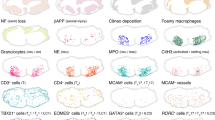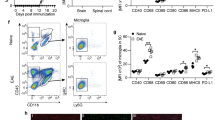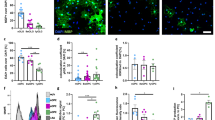Abstract
Multiple sclerosis is among the most common causes of neurological disabilities in young adults. Over the past decade, several therapeutic strategies have emerged as having potential neuroprotective and neuroregenerative properties. We investigated the effect of intranasal administration of LINGO-1–directed siRNA-loaded chitosan nanoparticles on demyelination and remyelination processes in a rat model of demyelination. Adult male Wistar rats were randomly assigned to one of 6 groups (n = 10 each) and subjected to intrapontine stereotaxic injection of ethidium bromide (EB) to induce demyelination. EB-treated rats were either left untreated or received intranasal LINGO-1–directed siRNA–chitosan nanoparticles from day 1 to day 7 (demyelination group) or from day 7 to day 21 (remyelination group) after EB injection. Chitosan nanoparticle (50 μl) was given alone after EB stereotaxic injection for both demyelination and remyelination groups. Two additional groups received 10 μl of saline by stereotaxic injection, followed by intranasal saline as controls for demyelination and remyelination groups (n = 10/group). Behavioural testing was conducted for all rats, as well as terminal biochemical assays and pathological examination of pontine tissues were done. After EB injection, rats had compromised motor performance and coordination. Pathological evidence of demyelination was observed in pontine tissue and higher levels of caspase-3 activity were detected compared to control rats. With LINGO-1–directed siRNA–chitosan nanoparticle treatment, animals performed better than controls. Remyelination-treated group showed better motor performance than demyelination group. LINGO-1 downregulation was associated with signs of repair in histopathological sections, higher expression of pontine myelin basic protein (MBP) mRNA and protein and lower levels of caspase-3 activity indicating neuroprotection and remyelination enhancement.




Similar content being viewed by others
Abbreviations
- EB:
-
Ethidium bromide
- MBP:
-
Myelin basic protein
- OPCs:
-
Oligodendrocyte precursor cells
- SiRNA:
-
Small interfering RNA
References
Aartsma-Rus A, van Putten M (2014) Assessing functional performance in the mdx mouse model. J Vis Exp. https://doi.org/10.3791/51303
Agundez JA, Jimenez-Jimenez FJ, Alonso-Navarro H, Garcia-Martin E (2015) The potential of LINGO-1 as a therapeutic target for essential tremor. Expert Opin Ther Targets 19:1139–1148. https://doi.org/10.1517/14728222.2015.1028360
Al-Ghananeem AM, Saeed H, Florence R, Yokel RA, Malkawi AH (2010) Intranasal drug delivery of didanosine-loaded chitosan nanoparticles for brain targeting; an attractive route against infections caused by AIDS viruses. J Drug Target 18:381–388. https://doi.org/10.3109/10611860903483396
Beckmann DV, Carvalho FB, Mazzanti CM, Dos Santos RP, Andrades AO, Aiello G, Rippilinger A, Graca DL, Abdalla FH, Oliveira LS, Gutierres JM, Schetinger MR, Mazzanti A (2014) Neuroprotective role of quercetin in locomotor activities and cholinergic neurotransmission in rats experimentally demyelinated with ethidium bromide. Life Sci 103:79–87. https://doi.org/10.1016/j.lfs.2014.03.033
Bondan EF, Martins Mde F, Bernardi MM (2015) Propentofylline reverses delayed remyelination in streptozotocin-induced diabetic rats. Arch Endocrinol Metab 59:47–53. https://doi.org/10.1590/2359-3997000000009
Bourikas D, Mir A, Walmsley AR (2010) LINGO-1-mediated inhibition of oligodendrocyte differentiation does not require the leucine-rich repeats and is reversed by p75(NTR) antagonists. Mol Cell Neurosci 45:363–369. https://doi.org/10.1016/j.mcn.2010.07.009
Boyd A, Zhang H, Williams A (2013) Insufficient OPC migration into demyelinated lesions is a cause of poor remyelination in MS and mouse models. Acta Neuropathol 125:841–859. https://doi.org/10.1007/s00401-013-1112-y
Cadavid D, Balcer L, Galetta S, Aktas O, Ziemssen T, Vanopdenbosch L, Butzkueven H, Ziemssen F, Massacesi L, Chai Y, Xu L, Freeman S (2015) Efficacy analysis of the anti-LINGO-1 monoclonal antibody BIIB033 in acute optic neuritis: the RENEW trial Neurology 84:Poster p7.202
Cao J, Wang J, Dwyer JB, Gautier NM, Wang S, Leslie FM, Li MD (2013) Gestational nicotine exposure modifies myelin gene expression in the brains of adolescent rats with sex differences. Transl Psychiatry 3:e247. https://doi.org/10.1038/tp.2013.21
Caprariello AV, Mangla S, Miller RH, Selkirk SM (2012) Apoptosis of oligodendrocytes in the central nervous system results in rapid focal demyelination. Ann Neurol 72:395–405. https://doi.org/10.1002/ana.23606
Casciola-Rosen L, Nicholson DW, Chong T, Rowan KR, Thornberry NA, Miller DK, Rosen A (1996) Apopain/CPP32 cleaves proteins that are essential for cellular repair: a fundamental principle of apoptotic death. J Exp Med 183:1957–1964
Chang A, Staugaitis SM, Dutta R, Batt CE, Easley KE, Chomyk AM, Yong VW, Fox RJ, Kidd GJ, Trapp BD (2012) Cortical remyelination: a new target for repair therapies in multiple sclerosis. Ann Neurol 72:918–926. https://doi.org/10.1002/ana.23693
Corbet C, Ragelle H, Pourcelle V, Vanvarenberg K, Marchand-Brynaert J, Preat V, Feron O (2016) Delivery of siRNA targeting tumor metabolism using non-covalent PEGylated chitosan nanoparticles: identification of an optimal combination of ligand structure, linker and grafting method. J Control Release 223:53–63. https://doi.org/10.1016/j.jconrel.2015.12.020
Davis ME, Zuckerman JE, Choi CHJ, Seligson D, Tolcher A, Alabi CA, Yen Y, Heidel JD, Ribas A (2010) Evidence of RNAi in humans from systemically administered siRNA via targeted nanoparticles. Nature 464:1067–1070. https://doi.org/10.1038/nature08956
Deiss A, Brecht I, Haarmann A, Buttmann M (2013) Treating multiple sclerosis with monoclonal antibodies: a 2013 update. Expert Rev Neurother 13:313–335. https://doi.org/10.1586/ern.13.17
Dubois-Dalcq M, Ffrench-Constant C, Franklin RJ (2005) Enhancing central nervous system remyelination in multiple sclerosis. Neuron 48:9–12. https://doi.org/10.1016/j.neuron.2005.09.004
El-Tallawy HN, Farghaly WMA, Badry R, Metwally NA, Shehata GA, Rageh TA, El Hamed MA, Kandil MR (2016) Prevalence of multiple sclerosis in Al Quseir city, Red Sea Governorate, Egypt. Neuropsychiatr Dis Treat 12:155–158. https://doi.org/10.2147/NDT.S87348
Goudarzvand M, Javan M, Mirnajafi-Zadeh J, Mozafari S, Tiraihi T (2010) Vitamins E and D3 attenuate demyelination and potentiate remyelination processes of hippocampal formation of rats following local injection of ethidium bromide. Cell Mol Neurobiol 30:289–299. https://doi.org/10.1007/s10571-009-9451-x
Hagemeyer N, Boretius S, Ott C, Von Streitberg A, Welpinghus H, Sperling S, Frahm J, Simons M, Ghezzi P, Ehrenreich H (2012) Erythropoietin attenuates neurological and histological consequences of toxic demyelination in mice. Mol Med 18:628–635. https://doi.org/10.2119/molmed.2011.00457
Hao C, Wang W, Wang S, Zhang L, Guo Y (2017) An overview of the protective effects of chitosan and acetylated chitosan oligosaccharides against neuronal disorders. Mar Drugs 15. https://doi.org/10.3390/md15040089
Hernandez TD, Schallert T (1988) Seizures and recovery from experimental brain damage. Exp Neurol 102:318–324
Ji B, Li M, Wu WT, Yick LW, Lee X, Shao Z, Wang J, So KF, McCoy JM, Pepinsky RB, Mi S, Relton JK (2006) LINGO-1 antagonist promotes functional recovery and axonal sprouting after spinal cord injury. Mol Cell Neurosci 33:311–320. https://doi.org/10.1016/j.mcn.2006.08.003
Kim ID, Shin JH, Kim SW, Choi S, Ahn J, Han PL, Park JS, Lee JK (2012) Intranasal delivery of HMGB1 siRNA confers target gene knockdown and robust neuroprotection in the postischemic brain. Mol Ther 20:829–839. https://doi.org/10.1038/mt.2011.291
Mi S, Lee X, Shao Z, Thill G, Ji B, Relton J, Levesque M, Allaire N, Perrin S, Sands B, Crowell T, Cate RL, McCoy JM, Pepinsky RB (2004) LINGO-1 is a component of the Nogo-66 receptor/p75 signaling complex. Nat Neurosci 7:221–228. https://doi.org/10.1038/nn1188
Michel K, Zhao T, Karl M, Lewis K, Fyffe-Maricich SL (2015) Translational control of myelin basic protein expression by ERK2 MAP kinase regulates timely remyelination in the adult brain. J Neurosci 35:7850–7865. https://doi.org/10.1523/jneurosci.4380-14.2015
Munzel EJ, Williams A (2013) Promoting remyelination in multiple sclerosis-recent advances. Drugs 73:2017–2029. https://doi.org/10.1007/s40265-013-0146-8
Nayerossadat N, Maedeh T, Ali PA (2012) Viral and nonviral delivery systems for gene delivery. Adv Biomed Res 1:27. https://doi.org/10.4103/2277-9175.98152
Nishikawa M, Yamauchi M, Morimoto K, Ishida E, Takakura Y, Hashida M (2000) Hepatocyte-targeted in vivo gene expression by intravenous injection of plasmid DNA complexed with synthetic multi-functional gene delivery system. Gene Ther 7:548–555. https://doi.org/10.1038/sj.gt.3301140
Pangestuti R, Kim SK (2010) Neuroprotective properties of chitosan and its derivatives. Mar Drugs 8:2117–2128. https://doi.org/10.3390/md8072117
Pepinsky RB, Shao Z, Ji B, Wang Q, Meng G, Walus L, Lee X, Hu Y, Graff C, Garber E, Meier W, Mi S (2011) Exposure levels of anti-LINGO-1 Li81 antibody in the central nervous system and dose-efficacy relationships in rat spinal cord remyelination models after systemic administration. J Pharmacol Exp Ther 339:519–529. https://doi.org/10.1124/jpet.111.183483
Podbielska M, Banik NL, Kurowska E, Hogan EL (2013) Myelin recovery in multiple sclerosis: the challenge of remyelination. Brain Sci 3:1282–1324. https://doi.org/10.3390/brainsci3031282
Ragelle H, Riva R, Vandermeulen G, Naeye B, Pourcelle V, Le Duff CS, D’Haese C, Nysten B, Braeckmans K, De Smedt SC, Jerome C, Preat V (2014) Chitosan nanoparticles for siRNA delivery: optimizing formulation to increase stability and efficiency. J Control Release 176:54–63. https://doi.org/10.1016/j.jconrel.2013.12.026
Satoh J, Tabunoki H, Yamamura T, Arima K, Konno H (2007) TROY and LINGO-1 expression in astrocytes and macrophages/microglia in multiple sclerosis lesions. Neuropathol Appl Neurobiol 33:99–107. https://doi.org/10.1111/j.1365-2990.2006.00787.x
Shields SA, Gilson JM, Blakemore WF, Franklin RJ (1999) Remyelination occurs as extensively but more slowly in old rats compared to young rats following gliotoxin-induced CNS demyelination. Glia 28:77–83
Tran JQ, Rana J, Barkhof F, Melamed I, Gevorkyan H, Wattjes MP, de Jong R, Brosofsky K, Ray S, Xu L, Zhao J, Parr E, Cadavid D (2014) Randomized phase I trials of the safety/tolerability of anti-LINGO-1 monoclonal antibody BIIB033. Neurol Neuroimmunol Neuroinflamm 1:e18. https://doi.org/10.1212/nxi.0000000000000018
Wei P, Ma P, Xu QS, Bai QH, Gu JG, Xi H, Du YG, Yu C (2012) Chitosan oligosaccharides suppress production of nitric oxide in lipopolysaccharide-induced N9 murine microglial cells in vitro. Glycoconj J 29:285–295. https://doi.org/10.1007/s10719-012-9392-3
Wu HF, Cen JS, Zhong Q, Chen L, Wang J, Deng DY, Wan Y (2013) The promotion of functional recovery and nerve regeneration after spinal cord injury by lentiviral vectors encoding Lingo-1 shRNA delivered by Pluronic F-127. Biomaterials 34:1686–1700. https://doi.org/10.1016/j.biomaterials.2012.11.013
Zhao C, Fancy SP, Kotter MR, Li WW, Franklin RJ (2005) Mechanisms of CNS remyelination--the key to therapeutic advances. J Neurol Sci 233:87–91. https://doi.org/10.1016/j.jns.2005.03.008
Acknowledgements
The authors are grateful to Dr. Teshreen M. Zeitoun, Ass. Prof in the Department of Medical Histology and Cell Biology-Alexandria Faculty of Medicine for her great support in Luxol fast blue staining and interpretation; and to Dr. Bassma El-Saba, Professor of Pathology-Alexandria Faculty of Medicine for her assistance in the histopathology analysis.
Author information
Authors and Affiliations
Corresponding author
Ethics declarations
Ethical approval
All applicable international, national, and/or institutional guidelines for the care and use of animals were followed. Additionally, all procedures performed involving animals were in accordance with the ethical standards of Alexandria University, Egypt.
Conflict of interest
The authors declare that they have no conflict of interest.
Additional information
Publisher’s note
Springer Nature remains neutral with regard to jurisdictional claims in published maps and institutional affiliations.
Electronic supplementary material
ESM 1
(DOCX 14 kb)
Rights and permissions
About this article
Cite this article
Youssef, A.E.H., Dief, A.E., El Azhary, N.M. et al. LINGO-1 siRNA nanoparticles promote central remyelination in ethidium bromide-induced demyelination in rats. J Physiol Biochem 75, 89–99 (2019). https://doi.org/10.1007/s13105-018-00660-6
Received:
Accepted:
Published:
Issue Date:
DOI: https://doi.org/10.1007/s13105-018-00660-6




